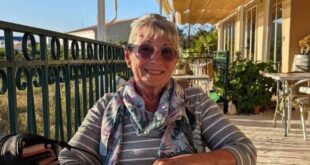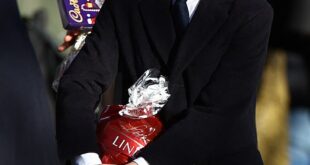Decisive action: the Battle of Camperdown in October 1797 was regarded as the Royal Navy’s greatest triumph, until Trafalgar
 SUNDAY SUPPLEMENT: Researching the history of Croydon’s part in the wars fought across Europe and North America in the late 18th and early 19th centuries has taken DAVID MORGAN, right, in another, somewhat unexpected direction
SUNDAY SUPPLEMENT: Researching the history of Croydon’s part in the wars fought across Europe and North America in the late 18th and early 19th centuries has taken DAVID MORGAN, right, in another, somewhat unexpected direction
Researching a particular topic can often take you down a rabbit hole. I was completely focused on a particular theme recently when a couple of sentences in an old newspaper cutting caught my eye. They had nothing to do with my research, but they looked intriguing.
“The Dutch Admiral Story has gone to reside in Croydon on his parole. His excursions through the neighbouring country are limited, but he is not to come within 10 miles of the capital.”
The sentences were on the front page of The London Chronicle, published on Tuesday December 14, 1799.
So what’s the story with Admiral Story? Why was he on parole? Why Croydon?

Dutch sea master: Admiral Samuel Story
The history of Samuel Story, a Vice Admiral in the Batavian Navy, provides an insight into the wars between Britain and the Dutch in the late 1700s, a period of great anti-monarchist revolutions across Europe and in north America, and illustrates how prisoners of war, or at least captured senior officers, were treated at that time.
Batavia or, to be exact, the Batavian Republic, was the name given for 11 years from 1795 to what we now know as the Netherlands, but then was a client state of Napoleon’s France.
So much so that in 1806 the country changed its name to become the Kingdom of Holland, where the King was Louis Bonaparte, Napoleon’s brother.
If the name “Batavia” rings a bell somewhere in the depths of your memory, it would be because this was the Dutch name given to the city we now know as Jakarta, the capital of modern-day Indonesia. This was once the centre of the Dutch East Indies trading company.
In the late 18th Century, Britain was not the only European nation with trading and imperial ambitions in far-flung corners of the world that depended on a large, ocean-going fleet of warships, and this was something which was often the cause of fierce conflict.
Samuel Story was born in Maasbommel, in the Dutch province of Gelderland, in 1752. At the age of 18, in 1770, he joined the Dutch navy, or what was called “the Admiralty of the Maze”, which was the admiralty of Rotterdam, the oldest of the five Dutch admiralties in 1770.
In July 1774, Story was made a lieutenant, a junior officer, on the 20-gun corvette, Orangezaal, with a crew of 150. His first command came in 1781 when he was given charge of 36-gun frigate, Jason. He was promoted again in 1793, being appointed captain of the 40-gun frigate Pollux at Hellevoertsluis, a port which could accommodate most of the Rotterdam fleet.

Story’s newspaper story: the London Chronicle report in December 1799
In February 1796, with the Dutch now effectively under French control, Story was made Rear Admiral aboard the Staaten Generaal, the ship in which he would fight the British fleet in October 1797 at the Battle of Camperdown, off the coast of Holland. It was a decisive and bloody encounter, the most significant action between British and Dutch forces during the French Revolutionary Wars.
It resulted in a complete victory for the British, who captured 11 Dutch ships without losing any of their own.
The Dutch fleet under Admiral Jan de Winter had been blockaded for many months by the British, but when Admiral Adam Duncan’s fleet had to put into Yarmouth to resupply, the Dutch fleet seized the chance to break out and raid England’s North Sea coast. When they returned to their home harbour on October 11, Admiral Duncan and the Royal Navy were waiting for them.
Story, with a crew of 500, lost 20 of his men killed, with 40 wounded.

Rotterdam Admiralty: the Dutch port had grown in trading and naval influence around the world, particularly in the East Indies, from the 1600s
His ship, though set on fire twice, came off relatively unscathed. More than 1,100 men were killed or wounded and nearly 4,000 men were taken prisoner, among them Admiral de Winter. This finished the Dutch as an independent naval fighting force.
The battle was responsible for the phrase, “pinning your colours to the mast” entering the English language.
Admiral Duncan, in charge of the British fleet on HMS Venerable, was in the thick of the action when its mast was blown apart by canon fire. The absence of an admiral’s flag in battle was an acknowledged sign of surrender, so a midshipman, Jack Crawford, climbed the remnants of the mast amid the heavy gunfire and explosions and nailed the standard back, to be known as the “Hero of Camperdown” for his exploits.

Cartoon figure: how Admiral Story was ridiculed in the English press after his surrender
Story was now one of the leading figures in a beaten navy.
It was to be two years before the British and Dutch fleets were to come face to face with each other again, but this time there was a very different outcome.
On August 30, 1799, the Dutch fleet under Story, consisting of eight ships of the line, three frigates and one sloop were caught off the coast at Vlieter, near to Wieringen. Conscious of the turbulent political situation in that part of Batavia – where many were still loyal to the Dutch monarchy – the British commander, Admiral Sir Andrew Mitchell, urged Story to change sides and join the supporters of the Prince of Orange against the French-imposed republic.
The Dutch sailors, conscious of the beating they received at the hands of the British at Camperdown, refused to fight. Despite Admiral Story’s pleas, the mutineers aboard the majority of the ships won the day. Their decision left Story with no other choice but to surrender his fleet. A Batavian ensign captured that day by Admiral Mitchell can be seen in the Royal Naval Museum at Greenwich today.
With his surrender, Story was taken as a prisoner of war. However, as a high-ranking officer, he would have been treated very differently to his men.
Admiral de Winter had been held in England for a year after his capture at the Battle of Camperdown. When he was released in December 1798, he returned to Amsterdam where he praised the English for the way in which he was treated. Admiral Duncan had held him on his flagship until de Winter was released on parole in London. Despite being enemies on the water, they grew to become firm friends, with Duncan presenting him with his miniature portrait painted by Daniel Orme.
In a speech on his return to Amsterdam, de Winter said: “Worthy burghers! I must not conceal from you that the noble liberality of the English nation since this bloody contest justly entitles them to your admiration.”
Wars between England or Britain and the Dutch had raged over much of the previous century, England was used to processing prisoners. Between January 1 1796 and March 14 1798, 316 Dutch officers were returned together with 416 men. In that same period, 64 British officers were returned together with 290 men.

The surrender of the fleet: an 18th Century engraving records the end for the Dutch navy and Admiral Samuel Story
In 1784, a prison had been built at Fishponds, near Bristol to help manage the prisoners of war. That year there were 774 Spaniards and 13 Dutchmen incarcerated in the new jail.
Many Dutch prisoners were held at Portchester Castle, near Portsmouth.
But Admiral Story probably never saw the inside of a prison. Officers were treated with the honour which was expected to be shown to them, no matter which side they were on. Houses were found for them to stay in, with some local travel limitations imposed.
No details have survived about where Story lived while he was in Croydon and there is no certain date when he was released, although it occurred after the signing of the Treaty of Amiens on March 27, 1802, which established a peace (albeit an uneasy one) between England, France, Spain and the Batavian Republic.
Story might have wished that he could have stayed on in Croydon. On his return home, Story was convicted for dereliction of duty, cowardice and disloyalty.
He was sentenced to banishment for life, on penalty of beheading. He fled to exile in Germany, living in the port city of Bremen for a while.
In 1811, in Cleves in Germany, Story died from dropsy (what we now call edema). He never managed to clear his name. He did try. In 1805, he published an autobiography, Verantwoording van Samuel Story, or The Accountability of Samuel Story.
But the decision he took on August 30 1799 would hanut him for the rest of his days.
- David Morgan is a former Croydon headteacher, now the volunteer education officer at Croydon Minster, who offers tours or illustrated talks on the history around the Minster for local community groups
If you would like a group tour of Croydon Minster or want to book a school visit, then ring the Minster Office on 020 688 8104 or go to the website on www.croydonminster.org and use the contact page
Some previous articles by David Morgan:
 Inside Croydon – If you want real journalism, delivering real news, from a publication that is actually based in the borough, please consider paying for it. Sign up today: click here for more details
Inside Croydon – If you want real journalism, delivering real news, from a publication that is actually based in the borough, please consider paying for it. Sign up today: click here for more details
- If you have a news story about life in or around Croydon, or want to publicise your residents’ association or business, or if you have a local event to promote, please email us with full details at inside.croydon@btinternet.com
 As featured on Google News Showcase
As featured on Google News Showcase
 ROTTEN BOROUGH AWARDS: In January 2024, Croydon was named among the country’s rottenest boroughs for a SEVENTH successive year in the annual round-up of civic cock-ups in Private Eye magazine
ROTTEN BOROUGH AWARDS: In January 2024, Croydon was named among the country’s rottenest boroughs for a SEVENTH successive year in the annual round-up of civic cock-ups in Private Eye magazine
Source link



